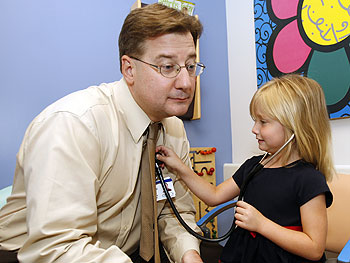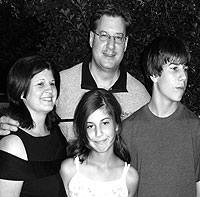Growing up in northeastern Ohio, Thomas Ferkol Jr., M.D., lived among the Old-Order Amish communities. When he was young, his father taught physical education and art in a small school system in Geauga County, where many of his students were Amish. As an unexpected twist, Ferkol, a pediatric physician-scientist working on cystic fibrosis and other lung diseases in children, has found through patients he treats at St. Louis Children’s Hospital that a rare genetic lung disease is common in Amish and Mennonite populations.

Ferkol, director of the Division of Pediatric Allergy and Pulmonary Medicine and associate professor of pediatrics and of cell biology and physiology, is one of a handful of pediatric pulmonologists in the country who study primary ciliary dyskinesia (PCD), an unusual cause of persistent wheezing and coughing in children. Estimated to occur in 1 of every 12,000 births, PCD is a genetic disorder that results in chronic infections of the respiratory tract.
Cilia are tiny, beating hair-like structures on the airway surface that protect the lung and move fluids, mucus and inhaled particulates out of the respiratory tract. In PCD, the cilia do not beat correctly. As a result, the impaired clearance of airway secretions leads to chronic bronchitis, which progresses to bronchiectasis, the weakening and widening of the passages, or even respiratory failure. About half of patients with PCD have reversed internal organs, called situs inversus, and males are usually infertile.
While leading the School of Medicine research team that is part of a national consortium investigating the genetic causes of PCD, Ferkol became fascinated by the discovery of PCD in several children and adults from rural Amish and Mennonite communities in the Midwest. Physicians in the National Institutes of Health-supported consortium are trying to understand the genetics of PCD in these families.
Their relative isolation and meticulous record-keeping make the Amish families ideal for genetic studies, Ferkol says.
“They have been very interested in helping us understand the clinical manifestations and genetics of PCD in their community,” he says. “The parents all want to know how best to treat this disease in their children. I assumed that since we’re dealing with a large consanguineous family that we’d be talking about a single gene and a single PCD-causing mutation, but, boy, was I wrong. The genetics are more complex than I had expected.”
Ferkol was recruited to the Department of Pediatrics in 2000 as director of the Cystic Fibrosis Center at the School of Medicine and St. Louis Children’s Hospital by Alan L. Schwartz, Ph.D., M.D., the Harriet B. Spoehrer Professor and head of pediatrics.
“Tom Ferkol is a gifted clinician, committed educator and leading investigator in the biology of cystic fibrosis and related disorders,” Schwartz says. “Tom has brought the Cystic Fibrosis Center to a nationally prominent position. His appointment last fall as division director gives us the opportunity to continue to advance. We look forward to the many years ahead under his leadership.”
While Ferkol remains co-director of the Cystic Fibrosis Center with Carolyn Cannon, Ph.D., M.D., and is very involved in the care of children with the disease, his research focus has increasingly shifted toward ciliopathies.
Passion for research

Ferkol said he has been interested in cystic fibrosis research since college.
While an undergraduate at Case Western Reserve University in Cleveland, Ferkol worked in a lab with researchers studying the role of Pseudomonas aeruginosa infections in cystic fibrosis patients.
“I was convinced then that I wanted to pursue a career in cystic fibrosis,” Ferkol says. “But my interest began to shift from infectious disease to pulmonary medicine shortly after I arrived at the University of North Carolina for my residency. Tom Boat, M.D., the chairman of pediatrics then, and Margaret Leigh, M.D., gradually convinced me that if I wanted to study cystic fibrosis, I should be a pulmonologist.
“I chose translational research because I’m a clinician at heart, and I am most interested in applying what we do in the laboratory to the patient,” he says. “The research that we do, ranging from the development of model airway systems to understand the pathogenesis of cystic fibrosis lung disease to application of alternative approaches for airway-specific drug delivery to the use of novel imaging studies that measure lung inflammation, could potentially be applied to patients.
“That’s what is exciting to me. I am reminded why I do research every time I care for a child with cystic fibrosis or PCD,” he says.
Since 2003, Ferkol and his colleagues have been involved in the Therapeutics Development Network formed by the Cystic Fibrosis Foundation to streamline testing of novel therapies to treat cystic fibrosis more effectively. Cystic fibrosis is the most common lethal, inherited disease of Caucasians and affects about 30,000 children and adults in the United States.
|
Thomas Ferkol Jr. Education: Case Western Reserve University, B.A., 1981; The Ohio State University College of Medicine, M.D., 1985 Family: Wife Sandra; son Thomas, 14; daughter Katherine, 11 Hobbies: Spending time with family, sports Travel: Last spring, the family went to Greece during spring break at his son’s request. “I’ve always enjoyed ancient history, and I had never been, so I didn’t need much convincing,” Ferkol says. “The trip gave me an opportunity to revisit Greek mythology and see places that I only knew through my imagination.” |
“While cystic fibrosis is a multisystem disease, affecting the pancreas, intestines, sweat glands and genitourinary tract, it’s the lung involvement that is primarily responsible for much of its morbidity and shortens the lives of patients,” Ferkol says. “But several newly developed drugs are showing promise, leading to hope that mutation-specific treatments and individualized therapies will be effective so these children will have longer, fuller lives.”
Career change
Ferkol’s path to become a researcher started out as a desire to be a teacher.
“As long as I can remember, I wanted to be like my father,” he says. “I still do. When I was in junior high, I told my dad I planned to be a teacher like him. He laughed and said, ‘Oh no, you don’t want to do that.’ So I responded, ‘Well, I guess I’ll become a doctor, then.’ To this day, I have no idea why I said that.”
The only physician in the family was Ferkol’s great-grandfather, Charles “Pop” Morgan, M.D., a family doctor in the northern panhandle of West Virginia. Ferkol keeps a photo in his office desk drawer of his great-grandfather standing in front of the horse and buggy he used to visit patients.
“I guess I didn’t listen to my father,” Ferkol says. “Much of what I do is teach, though it is far different from what I imagined as a teenager.
“I truly enjoy my job because I have the opportunity to do many different things every day,” he says. “But maybe it’s because I have a short attention span.”
Ferkol continues to collaborate on several projects with Leigh, professor and vice-chair of pediatrics at UNC.
“Tom has always been a great team player and organizer — as pitcher for the pediatric house staff and as pediatric chief resident at UNC, as director of the Washington University Cystic Fibrosis Learning and Leadership Collaborative and as site director for multicenter research projects,” Leigh said.
“He has a distinctive style for all that he does, like his red high-top tennis shoes he wears on the softball field, his tiny handwriting and his expressive drawings that have appeared as emblems for organizations. Tom’s bright, creative mind, matched with his equally quick wit, make all interactions with him informative, fun and memorable.”